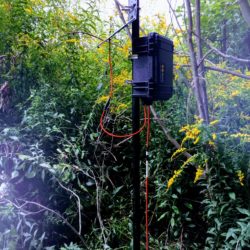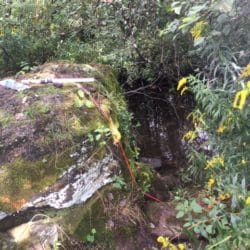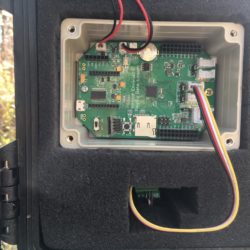Home › Forums › Mayfly Data Logger › Could Mayfly have been damaged during storm event?
- This topic has 4 replies, 2 voices, and was last updated 2021-09-05 at 12:38 PM by
Cheryl Nolan.
-
AuthorPosts
-
-
2021-09-03 at 11:58 AM #15851
I went out this week to do my inspection, cleaning and SIM card swap so that I could download the monitoring data. I typically stay long enough to verify the data is being downloaded onto the card (or is at least being sent to the board) by waiting for the lights to blink at the 5 minute pre-programmed interval. However, this time the unit wasn’t lighting up. I tried hitting the reset button and waited another 5 minutes, still no blinking lights. I then switched the power off, waited several seconds and turned it back on. Again, I waited the 5 minutes and still no blinking lights. BTW, the yellow battery charging light was lit the entire time I had the Pelican Box open. When I got back to the office to look at the data I noticed the data had stopped downloading on 8/12/2021. On that date we had a severe thunder storm. Is it possible the sensor was damaged during the storm?
-
2021-09-03 at 3:36 PM #15852
Hello Cheryl. I wonder could you say what its setting is. What is the geography, what wires are coming out, and how is it powered?
For electronics any form of excess voltage on processor pins can cause the device to fail. However its very difficult to figure out exactly what the cause is, as they say it can be complicated. You can inspect it visually to see if there are any burnt indications, also smell the board – fried electronics can leave a nasty wiff. Devices can fail by themselves, and typically if its an internal fault it fails in its “infancy” – first couple of weeks of running. Once it has seasoned, its unlikely to fail.
From my professional experience as an electronic engineer, usually if something fails, its easiest to just replace it. In commercial business they usually replace a device, and keep a count of the number of times something fails. I have seen some boards that had extreme lightening burns, but pretty unusual.
I once talked to a USGS guy who was managing stage gages sensors on the Ohio River for navigation ~ so water level was highly visible for ships to transit the river. They only use bubbler sensors there – no electrical connection with the water level. He talked about lightening strikes traveling down the Ohio river.
With lightening protection, you can think of it in two parts 1) protecting the processor with electrical clamps and diodes, and 2) diverting the electrical energy into the ground.
I was part of professional group that was discussing electronics (irrigation controllers) failing in Florida. The irrigation controller wires had a good electrical protection clamps. Florida is largely on a reef, prone to lightening, and its very difficult to conduct lightening into the ground because of that reef. Eventually they had to use a professional grounding method to ensure good grounding.
-
2021-09-03 at 3:59 PM #15853
Hi Neil,
The unit is a water monitoring station that has a CTD (conductivity, temperature and depth) sensor in the stream, in a remote section of the stream’s headwaters and the electronics are in a Pelican Box on the stream bank, mounted to an iron pipe. (see photos below) The only wires coming out run from the pelican box to the sensor and from the box to the solar panel that powers the unit. The second photo was taken during installation and is not, at final assembly, run across the huge rock in the photo, the cable runs slightly under the surface of the ground and into the sensor in the water. The inside of the box that houses the circuit board seems fine. I didn’t detect any odor that would indicate that something inside burnt up. In fact it looks completely normal. That’s why I was wondering if it could be the actual sensor that is located in the water. The unit has been in operation for more than a year and working well all along.
-
2021-09-03 at 6:54 PM #15857
Hi Cheryl, nice pics, good to have a record.
Typically on pressing reset, the LEDs dance red/green for a few seconds. The orange light would seem to indicate its getting power from the solar panel and charging the battery.
From the pictures it would seem that any “Static electricity” lightening would be channeled by the vegetation around it.
If the recording to your uSD stopped on 8/12/2021 that seems to me the processor failed. If the sensor failed, then you would still get readings, but they would be the default (typically -999.99). I did have one system (not a Mayfly) that was in a forested humid setting in N California Mattole forest, and some growths appeared across some lines (reset of course), that caused a failure.
When visiting a site I always take a spare Mayfly with me. I always compile my field software release to .HEX and keep a copy so that I swop out a mayfly relatively easily if needed.
Perhaps some of the other users could comment.
-
2021-09-05 at 12:38 PM #15859
Yes, Neil I agree. I should have thought of that. There’s nothing being recorded so it would make sense that it’s the processor that failed. I do have a spare processor. I’ll have to try replacing it. That would probably be the easiest thing to try.
Thanks for your help. It’s greatly appreciated.
-
-
AuthorPosts
- You must be logged in to reply to this topic.

 Welcome to EnviroDIY, a community for do-it-yourself environmental science and monitoring. EnviroDIY is part of
Welcome to EnviroDIY, a community for do-it-yourself environmental science and monitoring. EnviroDIY is part of 

